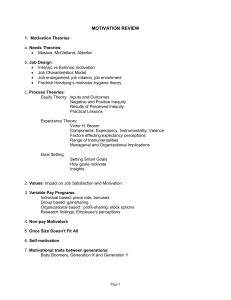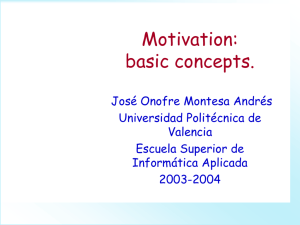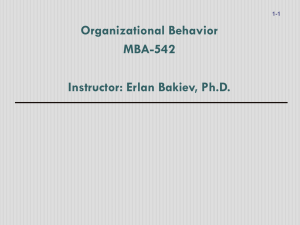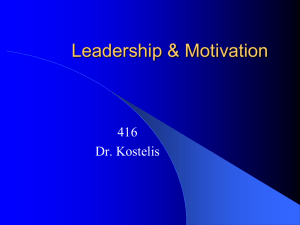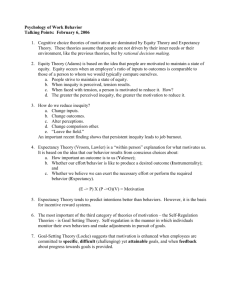Document
advertisement
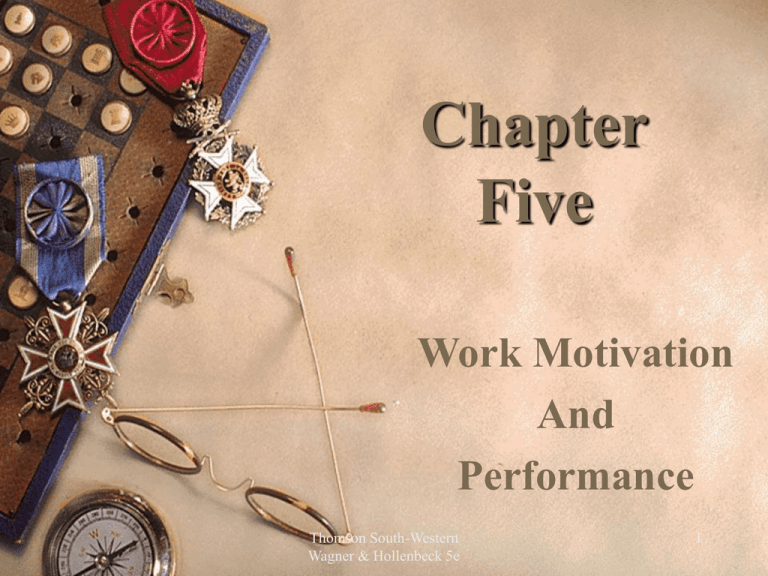
Chapter Five Work Motivation And Performance Thomson South-Western Wagner & Hollenbeck 5e 1 Chapter Overview This chapter examines the following topics: – A Model of Motivation and Performance • Expectancy Theory • Supplemental Theories • Overview of the Model – Valence: Need Theories • Maslow’s Need Hierarchy • Murray’s Theory of Manifest Needs – Instrumentality: Learning Theories • Reinforcement Theory • Social Theory – Expectancy: Self-Efficacy Theory • Self-Efficacy and Behavior • Sources of Self-Efficacy 2 Chapter Overview (cont.) This chapter examines the following topics: – Accuracy of Role Perceptions: Goal Setting Theory • Important Goal Attributes • Goal Commitment and Participation • Goals and Strategies – Ability and Experience Revisited • Nonmotivational Determinants of Performance • Experience and Cyclical Effects – High-Performance Work Systems • Merit Pay and Incentive Systems • Profit-Sharing and Cost-Savings Plans 3 Introduction One way for an organization to gain a competitive advantage over its rivals is to generate a more motivated workforce Motivation: refers to the energy a person is willing to devote to a task One way to create motivation is through rewards Perhaps the easiest thing to say to a manager, in theory, is that he or she should “pay for performance” or “link rewards to accomplishment” while perhaps the most difficult thing to do, in practice, is to implement this advice in a manner that does not backfire 4 A Model of Motivation and Performance Expectancy Theory: – Expectancy theory is a broad theory of motivation that attempts to explain the determinants of workplace attitudes and behaviors – Three major components underlie expectancy theory: • Valence: based on the assumption that at any given time, a person prefers certain outcomes to others • Instrumentality: a person’s belief about the relationship between performing an action and experiencing an outcome • Expectancy: beliefs about the link between making an effort and actually performing well 5 Supplemental Theories Two primary reasons explain why, to build a model of motivation and performance, expectancy theory needs to be supplemented with other motivation theories – A number of other theories deal in more detail with certain motivation components: • Need theories: provide insights into how valences develop and change over time • Learning theories: explain how perceptions of instrumentality arise • Self-efficacy theory: describes the origins of effortperformance expectancies and the ways they are maintained – Expectancy theory must be extended to explain outcomes other than desire and effort • To predict performance, expectancy theory requires information about human ability, goals, and strategies 6 Overview of the Model The model of motivation and performance built in this chapter consists of five components put together in four steps to explain three outcomes 7 Valance: Needs Theories People differ greatly in their preferences The goal for employers is to find exactly what drives each employee and then build reward systems around those drives, thus taking advantage of each person’s unique sets of interests and values When it comes to understanding how valences originate and why they differ among people, need theories can prove especially informative 8 Maslow’s Need Hierarchy Murray’s Theory of Manifest Needs Maslow’s Need Hierarchy: Murray’s Theory of Manifest Needs: – Abraham Maslow was a clinical psychologist and a pioneer in the development of need theories – Maslow’s need theory proposed the existence of five distinct types of needs: Physiological, Safety, Love, Esteem, and Selfactualization – Maslow argued these five needs influence motivation on the basis of prepotency which means that needs residing higher in the hierarchy can influence motivation only if lower needs are largely satisfied – Henry Murray’s theory of manifest needs defines needs as recurrent concerns for particular goals or end states – Each need consists of two components, the object toward which the need is directed and the intensity or strength of the need for that particular object – Murray regarded needs as something learned from interacting with the environment and proposed more than 20 needs – Other researchers expanded Murray’s work including David McClelland whose theory of motivation focused 9 on the need for achievement Instrumentality: Learning Theories To understand behavior, it must be known what people believe will lead to the attainment of what they want; these beliefs are referred to as instrumentalities The notion that people will generally behave so as to maximize pleasure and minimize pain expresses the concept of hedonism and is incorporated in virtually all modern theories of motivation, especially learning theories 10 Reinforcement Theory Reinforcement theory proposes that a person engages in a specific behavior because that behavior has been reinforced by a specific outcome – Garment factory and MBNA examples This theory is also known as operant learning in that the person must perform some operation to receive the reinforcing outcome; this is especially good for reinforcing simple or welllearned responses In some cases, complex behavior that might not occur on its own may need to be encouraged: – Shaping: rewarding successive approximations to a desired behavior – Extinction: a weakened response occurs because the desired outcome is no longer paired with some positive reinforcer – Negative reinforcement: the likelihood that a person will engage in a particular behavior increases because the behavior is followed by the removal of something the person dislikes – Punishment: the likelihood of a given behavior decreases 11 because it is followed by something the person dislikes Reinforcement Theory Punishment: – While coming up with rewards is sometimes difficult, most organizations can easily envision a wide variety of ways to punish people Punishment, by itself, can only suppress undesired behaviors not promote desired behaviors Organizations need to strive to punish employees effectively and several steps can be taken to move in this direction: – – – – – Discipline programs should be progressive Punishment should be immediate Punishment should be consistent Punishment should be impersonal Punishment should be documented 12 Social Learning Social learning theory was proposed by Albert Bandura and encompasses a theory of observational learning that holds that most people learn behaviors by observing others and then modeling the behaviors perceived as being effective Observational learning is in marked contrast to the process of learning through reinforcement and it better explains how people learn complex behavioral sequences This theory proposes that people can reinforce or punish their own behaviors; this is called self-reinforcement A self-reinforcing event occurs when: – Tangible rewards are readily available – People deny themselves free access to those rewards – They allow themselves to acquire the rewards only after achieving difficult self-set goals 13 Expectancy: Self-Efficacy Theory Self-Efficacy and Behavior: Sources of Self-Efficacy: – Self-efficacy refers to the judgment that people make about their ability to execute courses of action required to deal with prospective situations – Self-efficacy determines how much effort people will expend and how long they will persist in the face of obstacles or stressful experiences – For the most part, the positive aspects of high self-efficacy outweigh the negative side effects – Bandura identified 4 sources of self-efficacy beliefs: • • • • Past accomplishments Observation of others Verbal persuasion Logical verification Self-efficacy theory is particularly useful for explaining how expectancies are formed and suggesting how they might be changed Simply wanting to excel will not bring about high levels of effort unless the person has some belief that such performance is possible14 Accuracy of Role Perceptions: Goal-Setting Theory Role perceptions are people's beliefs about what they are supposed to accomplish on the job and how they should achieve those goals Goal-setting theory can foster understanding on how to enhance the accuracy of role perceptions 15 Important Goal Attributes More than 100 studies support the assertion that goals should be both specific and difficult Goal setting works most effectively when teamed with feedback Specific and difficult goals: – Are especially effective when incorporated into a continuous improvement cycle – Appear to promote greater effort and enhance persistence – Encourage people to develop effective task strategies and sharpen mental focus on the task – Direct attention to specific desired results 16 Goal Commitment and Participation and Goals and Strategies The extent to which a person feels committed to a goal can affect performance Research has examined several ways to increase commitment to difficult goals: – Degree to which goals are public rather than private – Self-setting of goals – Participation in the goalsetting process Research on goal setting and task strategies suggests that whereas setting specific and difficult goals may increase strategy development, the resulting strategies are not guaranteed to be effective Goal orientation: distinguishes between people who approach a task with the goal of learning how to improve themselves and those whose goals focus strictly on performing at a certain level 17 Ability & Experience Revisited: Nonmotivational Determinants of Performance Task performance is contingent upon the worker’s abilities Two things are worth noting with respect to nonmotivational determinants of performance: – People lacking the requisite abilities cannot perform a complex task even under the most favorable goalrelated circumstances – Subtle relationships exists among goal-setting, attention, and cognitive capacity that affect task performance Performance will be high when a person puts forth significant effort, directs this effort toward the right outcomes, and has the ability to execute the behaviors necessary for bringing about those outcomes 18 Experience and Cyclical Effects This step deals with the links that make the model dynamic over time: – The first link is a feedback loop that goes from performance to valence – The second link goes from performance to instrumentalities – The last link goes from performance to expectancy These three dynamic links in the motivation model suggest that motivation can change over time Motivation may be lost for three reasons: – Decreased self-efficacy – Projected instrumentalities fail to materialize – Faults are found with the initial valences 19 High-Performance Work Systems Consider some of the issues that arise when pay-for-performance programs are contemplated: – Should pay increases be based on outcomes that occur at the individual level, group level, or the organizational level? – If the firm pays on the individual level, should it establish the rules for payment in advance? – How large should incentives be? – How much variability should exist within and between job categories? – If the company decides to keep incentives at an organizational level, should it base the rewards on cost savings and distribute them yearly or base them on profits and distribute them on a deferred basis? 20 Merit-Pay and Incentive Systems and Profit-Sharing and Cost-Savings Plans Individual pay-for-performance plans base financial compensation on the accomplishments of individual workers Merit-based plans are the easiest to administer and control In designing merit-based programs, three considerations arise: – What will the average performer receive? – What will a poor performer receive? – How much will high performers receive? Profit-sharing and cost-savings plans tie pay to performance at a broader level Profit-sharing plans distribute organizational profits to employees; this plan is difficult for employees to see the connection between their activities and company profits Cost-savings plans pay workers bonuses out of the money the company has saved through the increased efficacy of its operations; this plan is easier for workers to see the connection between their own work and cost reductions 21

